高中英语片段教学教案
- 格式:docx
- 大小:10.67 KB
- 文档页数:4
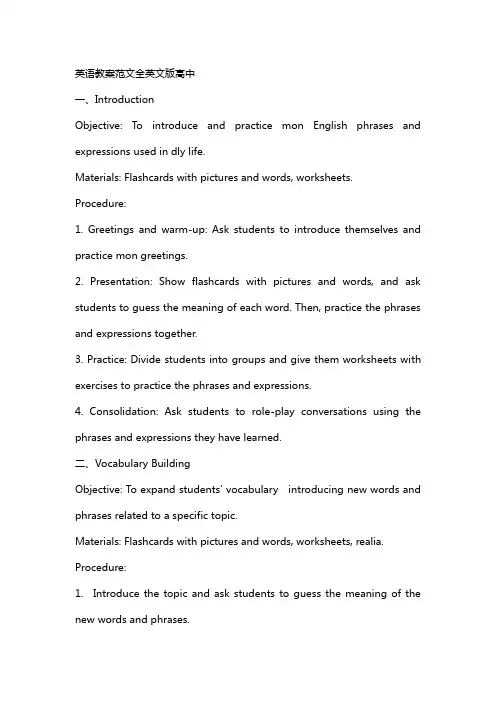
英语教案范文全英文版高中一、IntroductionObjective: To introduce and practice mon English phrases and expressions used in dly life.Materials: Flashcards with pictures and words, worksheets. Procedure:1. Greetings and warm-up: Ask students to introduce themselves and practice mon greetings.2. Presentation: Show flashcards with pictures and words, and ask students to guess the meaning of each word. Then, practice the phrases and expressions together.3. Practice: Divide students into groups and give them worksheets with exercises to practice the phrases and expressions.4. Consolidation: Ask students to role-play conversations using the phrases and expressions they have learned.二、Vocabulary BuildingObjective: To expand students' vocabulary introducing new words and phrases related to a specific topic.Materials: Flashcards with pictures and words, worksheets, realia. Procedure:1. Introduce the topic and ask students to guess the meaning of the new words and phrases.2. Presentation: Show flashcards with pictures and words, and ask students to match the words with their meanings. Then, practice the words and phrases together.3. Practice: Give students worksheets with exercises to practice the new words and phrases.4. Consolidation: Ask students to create sentences using the new words and phrases, and present them to the class.三、Listening and SpeakingObjective: To improve students' listening and speaking skills practicing dialogues and conversations.Materials: Audio recording, worksheets.Procedure:1. Ask students to listen to an audio recording and answer some questions about it.2. Presentation: Play the audio recording and ask students to repeat after the speaker. Then, practice the dialogues and conversations together.3. Practice: Divide students into prs or groups and give them worksheets with exercises to practice the dialogues and conversations.4. Consolidation: Ask students to role-play the dialogues and conversations with a partner or group, and then present them to the class.四、Reading and WritingObjective: To improve students' reading and writing skills analyzing and summarizing a text.Materials: Text, worksheets.Procedure:1. Ask students to read a text and answer some questions about it.2. Presentation: Discuss the text with students, and ask them to identify the mn ideas and supporting detls. Then, practice summarizing the text together.3. Practice: Give students worksheets with exercises to practice reading and writing skills, such as fill in the blanks, true or false, and matching.4. Consolidation: Ask students to write a summary of the text, and then present it to the class.五、Grammar ReviewObjective: To review and practice a specific grammar point. Materials: Worksheets, realia.Procedure:1. Review the grammar point and ask students to identify examples of the grammar rule in a text.2. Presentation: Expln the grammar rule and give students examples to practice. Then, practice the grammar point together.3. Practice: Give students worksheets with exercises to practice the grammar point.4. Consolidation: Ask students to create sentences using the grammar point, and present them to the class.六、Grammar FocusObjective: To focus on a specific grammar point and practice it through various activities.Materials: Worksheets, realia, flashcards.Procedure:1. Introduce the grammar point and ask students to identify examples in a given text.2. Presentation: Expln the grammar rule using flashcards, realia, and examples. Practice the grammar point together.3. Practice: Divide students into prs or groups and give them worksheets with exercises focusing on the grammar point.4. Consolidation: Ask students to create sentences using the grammar point in a real-life context and present them to the class.七、Listening ComprehensionObjective: To improve students' listening prehension skills understanding and interpreting audio materials.Materials: Audio recording, worksheets.Procedure:1. Ask students to listen to an audio recording and answer some pre-listening questions.2. Presentation: Play the audio recording and ask students to take notes. Discuss the content and answer prehension questions.3. Practice: Give students worksheets with exercises based on the audio recording, such as multiple choice, true or false, and fill in the blanks.4. Consolidation: Ask students to summarize the audio recording in their own words and present it to the class.八、Speaking SkillsObjective: To enhance students' speaking skills through discussions, presentations, and role-plays.Materials: Worksheets, realia, flashcards.Procedure:1. Introduce the topic and ask students to express their opinions on the subject.2. Presentation: Provide students with prompts or questions related to the topic and facilitate a class discussion.3. Practice: Divide students into prs or groups and give them worksheets with speaking activities, such as role-plays and presentations.4. Consolidation: Ask students to present their speaking activities to the class and provide feedback on each other's performances.九、Writing SkillsObjective: To develop students' writing skills pleting different types of writing tasks.Materials: Worksheets, realia, writing prompts.Procedure:1. Introduce the writing task and provide students with a prompt or topic.2. Presentation: Expln the writing process and provide examples of the desired writing style. Guide students through the writing process.3. Practice: Give students worksheets with writing exercises, such as essays, reports, or letters.4. Consolidation: Ask students to share their written pieces with the class and provide feedback on each other's work.十、Cultural AwarenessObjective: To enhance students' cultural awareness and understanding through the study of English-speaking cultures.Materials: Worksheets, realia, audio recordings, videos.Procedure:1. Introduce the cultural topic and ask students to share their prior knowledge.2. Presentation: Provide information about the cultural topic using audio recordings, videos, realia, and worksheets. Discuss and pare the cultural aspects with students' own culture.3. Practice: Give students worksheets with activities related to the cultural topic, such as crossword puzzles, quizzes, or short essays.4. Consolidation: Ask students to reflect on the cultural topic and share their thoughts and experiences. Encourage a class discussion and promote cultural exchange.十一、Project WorkObjective: To apply the knowledge and skills learned in previous lessons to a group project.Materials: Project materials, worksheets.Procedure:1. Introduce the project topic and expln the objectives. Divide students into groups.2. Presentation: Provide guidelines and instructions for the project. brnstorm ideas and give examples.3. Practice: Allow students to work on their projects, providing support and guidance as needed.4. Consolidation: Ask students to present their projects to the class and provide feedback on each other's work.十二、Exam PreparationObjective: To prepare students for an uping exam reviewing key concepts and practicing exam questions.Materials: Exam review worksheets, past exam papers.Procedure:1. Expln the purpose of the lesson and review the exam format.2. Presentation: Go over key concepts and provide examples. Discuss exam strategies and tips.3. Practice: Give students exam review worksheets or past exam papers to practice.4. Consolidation: Conduct a mock exam or review session, allowing students to ask questions and clarify doubts.十三、Error CorrectionObjective: To help students identify and correct mon errors in their writing.Materials: Sample student essays, error correction worksheets. Procedure:1. Expln the importance of error correction and its role in improving writing skills.2. Presentation: Provide students with sample student essays contning mon errors. Discuss the errors and their corrections.3. Practice: Give students error correction worksheets to identify and correct errors in sample sentences or paragraphs.4. Consolidation: Encourage students to peer-edit each other's writing and provide feedback on errors.十四、Extension ActivitiesObjective: To provide additional practice and challenge for students who need further development.Materials: Extension worksheets, online resources.Procedure:1. Expln that these activities are optional and designed for students who want extra practice or a challenge.2. Presentation: Provide an overview of the extension activities and expln how to plete them.3. Practice: Allow students to work on the extension activities at their own pace, providing support as needed.4. Consolidation: Encourage students to share their pleted extension activities with the class and discuss their experiences.十五、Classroom Management and ReviewObjective: To review the lessons learned and evaluate student progress. Materials: Progress charts, self-assessment worksheets.Procedure:1. Ask students to reflect on what they have learned and their progress in the course.2. Presentation: Review key concepts, vocabulary, and skills covered in the course. Discuss any challenges or areas for improvement.3. Practice: Give students self-assessment worksheets to evaluate their own progress and identify areas they want to focus on.4. Consolidation: Conduct a class review session, allowing students to ask questions and clarify doubts. Discuss strategies for ongoingimprovement and provide feedback on student progress.重点和难点解析本文主要介绍了一篇高中英语教案范例,涵盖了从问候、词汇学习、听力与口语、阅读与写作、语法复习到项目工作、考试准备、错误纠正、拓展活动、课堂管理与复习等多个方面的教学内容。
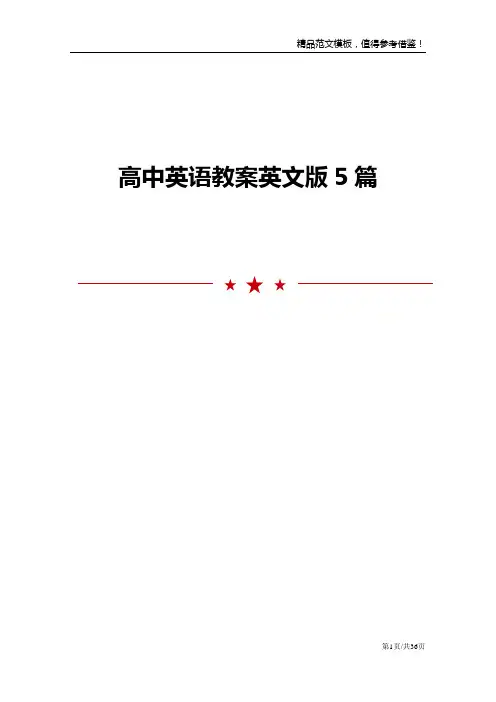
高中英语教案英文版5篇高中英语教案英文版5篇教案可以恰当地选择和运用教学方法,调动学生学习的积极性,面向大多数学生,同时注意培养优秀生和提高后进生,使全体学生都得到发展。
以下是带来的内容,感谢您的阅读,希望能帮助到您!高中英语教案英文版1Teaching Procedures of Period 1:Step1.Warming up (15 mins)Ss know a lot about sports from everyday life and media, so I arrange sucha task -discussion(group of 4): Q: What do you know about sports?During this process, if Ss can’t express themselves in English, Chinese isalso all right. Besides, it is agood chance to present new words. If necessary, I will make somecomplements. At the same time, I will present them as many pictures about sportsas possible.Possible response:school sports meetSports meet the National Gamesthe Asian Gamesthe Olympic Gamesthe World Cupetcball games: volleyball, basket ball, football, table tennis, tennis,,golfbadminton, bowling, baseball, American football, ice hockey etcEvents of sports track and field: relay race, long jump, high jump, polejump, discus, shot, javelin etcgymnastic: rings, double bars, high and low bars, horse , free exerciseswimming/shooting/skiing/ ice sports/diving/aquatic sports etcSport stars : Beckham, Mike Owen, Michael Jordan etc Purpose: This activity is designed to encourage students to think aboutsports and activaterelevant vocabulary.Step 2. Speaking(15 mins)Task1(pair work): Talk about their favourite sports, favourite sportsstars, and the reason why they like them, with the following expressions as aguide.(See SB p52) Task2(pair work): A survey about physical fitness (Seepostscript 1)Task3(group work): Add up their total scores and divide by the number ofpeople. Then get their group’s average scores. Discuss their survey answers.1). Do you think your group is doing well or not? Why ?2). How can you become fitter?高中英语教案英文版2教学目标Teaching aims and demands本单元的教学目标是使学生掌握表示判断和个人看法的常用语句,学会使用现在完成时的被动语态。
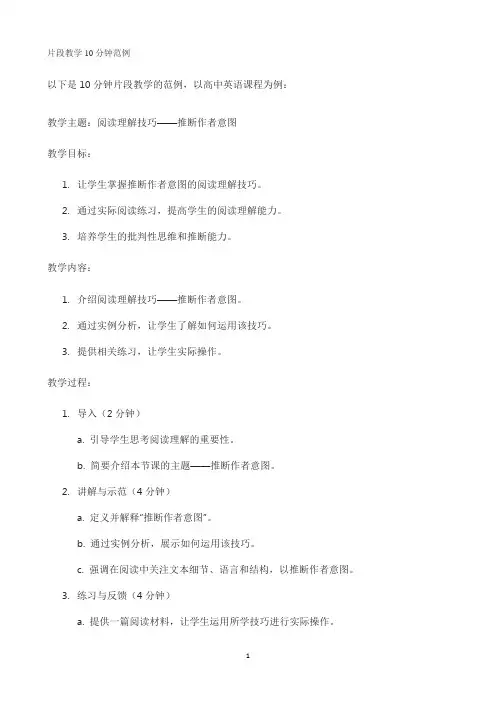
片段教学10分钟范例
以下是10分钟片段教学的范例,以高中英语课程为例:
教学主题:阅读理解技巧——推断作者意图
教学目标:
1.让学生掌握推断作者意图的阅读理解技巧。
2.通过实际阅读练习,提高学生的阅读理解能力。
3.培养学生的批判性思维和推断能力。
教学内容:
1.介绍阅读理解技巧——推断作者意图。
2.通过实例分析,让学生了解如何运用该技巧。
3.提供相关练习,让学生实际操作。
教学过程:
1.导入(2分钟)
a. 引导学生思考阅读理解的重要性。
b. 简要介绍本节课的主题——推断作者意图。
2.讲解与示范(4分钟)
a. 定义并解释“推断作者意图”。
b. 通过实例分析,展示如何运用该技巧。
c. 强调在阅读中关注文本细节、语言和结构,以推断作者意图。
3.练习与反馈(4分钟)
a. 提供一篇阅读材料,让学生运用所学技巧进行实际操作。
b. 鼓励学生小组讨论,分享彼此的推理和结论。
c. 教师对学生的答案进行点评和指导,强调推理的合理性和准确性。
4.总结与布置作业(1分钟)
a. 总结本节课的主要内容。
b. 布置相关练习,要求学生运用所学技巧完成。
c. 提醒学生注重阅读实践,提高阅读理解能力。
注意事项:
1.在讲解和示范环节,尽量使用简单明了的语言,避免过于复杂的术语。
2.在练习和反馈环节,要给予学生足够的思考和讨论时间,不要急于给出答案或评价。
3.在总结和布置作业环节,要强调阅读理解和推断作者意图的重要性,鼓励学生多加练
习。
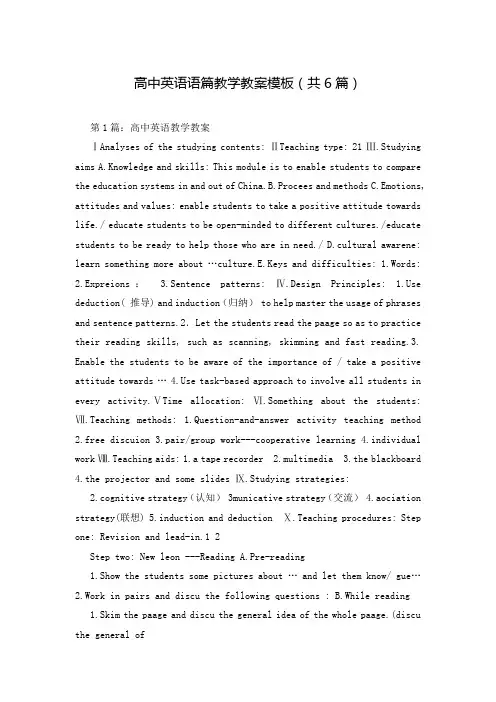
高中英语语篇教学教案模板(共6篇)第1篇:高中英语教学教案ⅠAnalyses of the studying contents: ⅡTeaching type: 21 Ⅲ.Studying aims A.Knowledge and skills: This module is to enable students to compare the education systems in and out of China.B.Procees and methods C.Emotions, attitudes and values: enable students to take a positive attitude towards life./ educate students to be open-minded to different cultures./educate students to be ready to help those who are in need./ D.cultural awarene: learn something more about …culture.E.Keys and difficulties: 1.Words: 2.Expreions: 3.Sentence patterns: Ⅳ.Design Principles: e deduction( 推导) and induction(归纳) to help master the usage of phrases and sentence patterns.2.Let the students read the paage so as to practice their reading skills, such as scanning, skimming and fast reading.3. Enable the students to be aware of the importance of / take a positive attitude towards … e task-based approach to involve all students in every activity.ⅤTime allocation: Ⅵ.Something about the student s: Ⅶ.Teaching methods: 1.Question-and-answer activity teaching method 2.free discuion 3.pair/group work---cooperative learning 4.individual work Ⅷ.Teaching aids: 1.a tape recorder 2.multimedia 3.the blackboard 4.the projector and some slides Ⅸ.Studying strategies:2.cognitive strategy(认知) 3municative strategy(交流) 4.aociation strategy(联想) 5.induction and deduction Ⅹ.Teaching procedures: Step one: Revision and lead-in.1 2Step two: New leon ---Reading A.Pre-reading1.Show the students some p ictures about … and let them know/ gue…2.Work in pairs and discu the following questions : B.While reading1.Skim the paage and discu the general idea of the whole paage.(discu the general ofeach paragraph)2.Read the text carefully and try to answer the following questions:3.Read the text again and fill in the following form:4.Listen to the tape and imitate its pronunciation.5.Read the paage aloud.6.Enjoy the beauty of the language.C.Post-reading:1.Post-reading discuion:2.Consolidation:a.Do some exercises to consolidate the …b.Write some sentences about … 3.Extension for writing … Ⅺ Summary and Homework:1.Do…/write…2.Go over what has covered today.Ⅻ Blackboard writing: ⅩⅢ.My intension of the design第2篇:少儿英语教案模板少儿英语教案模板一、Teaching Demands and Aims(教学目标)二、Teaching important and difficult point (教学重点)1、words2、sentences3、grammars三、Teaching Aids (教具)四、Teaching procedures(教学过程) Greeting(问候) warm up(热身)Review(复习) New Leon(新课) Step One: Step Two: Step Three: Follow up(叮咛)五、Homework(作业布置)作业的布置一、书面作业1、每节课后教师可适当选择课后习题(书本或课外参考书)及字母作业。
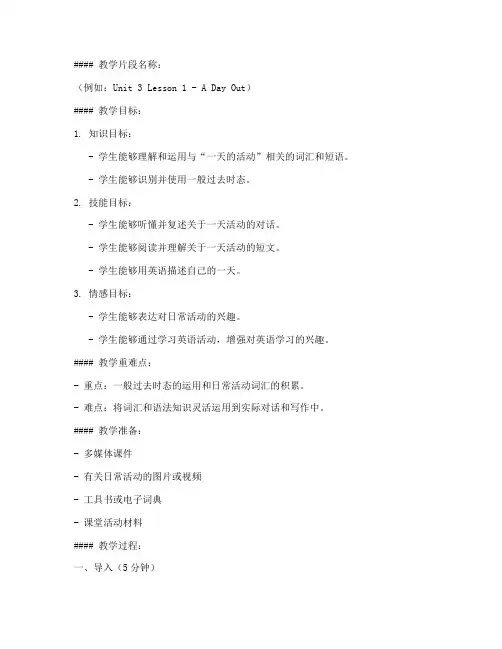
#### 教学片段名称:(例如:Unit 3 Lesson 1 - A Day Out)#### 教学目标:1. 知识目标:- 学生能够理解和运用与“一天的活动”相关的词汇和短语。
- 学生能够识别并使用一般过去时态。
2. 技能目标:- 学生能够听懂并复述关于一天活动的对话。
- 学生能够阅读并理解关于一天活动的短文。
- 学生能够用英语描述自己的一天。
3. 情感目标:- 学生能够表达对日常活动的兴趣。
- 学生能够通过学习英语活动,增强对英语学习的兴趣。
#### 教学重难点:- 重点:一般过去时态的运用和日常活动词汇的积累。
- 难点:将词汇和语法知识灵活运用到实际对话和写作中。
#### 教学准备:- 多媒体课件- 有关日常活动的图片或视频- 工具书或电子词典- 课堂活动材料#### 教学过程:一、导入(5分钟)1. 热身活动:教师展示日常活动的图片,引导学生用英语描述图片内容。
2. 问题导入:教师提问:“What do you usually do on weekends?”引导学生思考并回答。
二、新课呈现(20分钟)1. 词汇学习:- 教师通过PPT展示与“一天的活动”相关的词汇,如:go to school, have breakfast, do homework, watch TV, go to bed等。
- 学生跟读并尝试使用这些词汇造句。
2. 语法学习:- 教师讲解一般过去时的用法,并通过例句进行演示。
- 学生练习用一般过去时描述过去一天的活动。
3. 听力训练:- 播放关于一天活动的对话,让学生听取并回答问题。
- 教师解释听力材料中的难点词汇和语法结构。
三、课堂活动(15分钟)1. 角色扮演:学生分组,根据所学内容进行角色扮演,模拟一天的活动。
2. 小组讨论:教师提出问题,如:“What’s your favorite activity?” 学生分组讨论并分享。
四、巩固练习(10分钟)1. 填空练习:教师提供含有缺失词汇的句子,让学生填写正确的词汇。
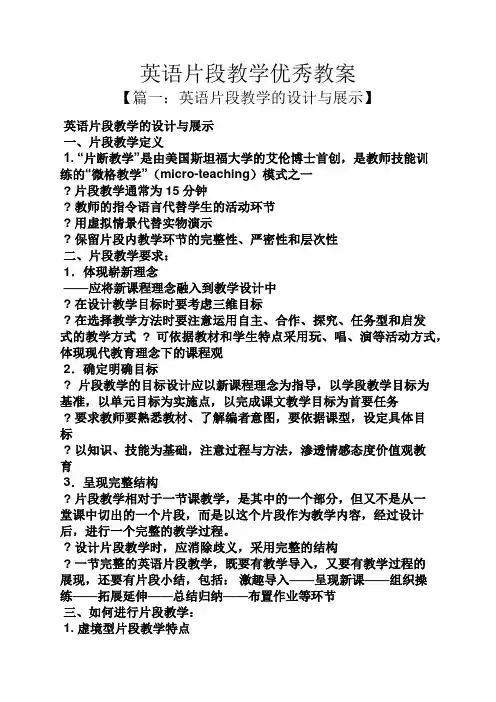
英语片段教学优秀教案【篇一:英语片段教学的设计与展示】英语片段教学的设计与展示一、片段教学定义1. “片断教学”是由美国斯坦福大学的艾伦博士首创,是教师技能训练的“微格教学”(micro-teaching)模式之一? 片段教学通常为15分钟? 教师的指令语言代替学生的活动环节? 用虚拟情景代替实物演示? 保留片段内教学环节的完整性、严密性和层次性二、片段教学要求:1.体现崭新理念——应将新课程理念融入到教学设计中? 在设计教学目标时要考虑三维目标? 在选择教学方法时要注意运用自主、合作、探究、任务型和启发式的教学方式? 可依据教材和学生特点采用玩、唱、演等活动方式,体现现代教育理念下的课程观2.确定明确目标? 片段教学的目标设计应以新课程理念为指导,以学段教学目标为基准,以单元目标为实施点,以完成课文教学目标为首要任务? 要求教师要熟悉教材、了解编者意图,要依据课型,设定具体目标? 以知识、技能为基础,注意过程与方法,渗透情感态度价值观教育3.呈现完整结构? 片段教学相对于一节课教学,是其中的一个部分,但又不是从一堂课中切出的一个片段,而是以这个片段作为教学内容,经过设计后,进行一个完整的教学过程。
? 设计片段教学时,应消除歧义,采用完整的结构? 一节完整的英语片段教学,既要有教学导入,又要有教学过程的展现,还要有片段小结,包括:激趣导入——呈现新课——组织操练——拓展延伸——总结归纳——布置作业等环节三、如何进行片段教学:1. 虚境型片段教学特点? 实践性——教学实践活动? 完整性——完整的教学设计教学目标、教学重难点、教学方法、完整的教学步骤、板书设计? 预设性——眼中有学生、心中有课堂,在设计时要预设师生交流情境 ? 虚拟性——没有实施对象,带有浓重的虚拟色彩2.创设虚拟情境? 在模拟教学情境时,可采用语言转化、角色扮演、板书示范、课堂用语等方面的细节来创设情境。
? 可用提问和模拟学生回答创设虚拟师生交流情境? 可布置两两对话、小组活动,创设生生互动的场面? 可用强化语、面部表情、肢体语言再现真实的教学情境? 还可模拟使用录音机、电脑,变静为动? 高年级还可虚拟争论,虚拟质疑,虚拟辩论,使课堂变得生动活泼。
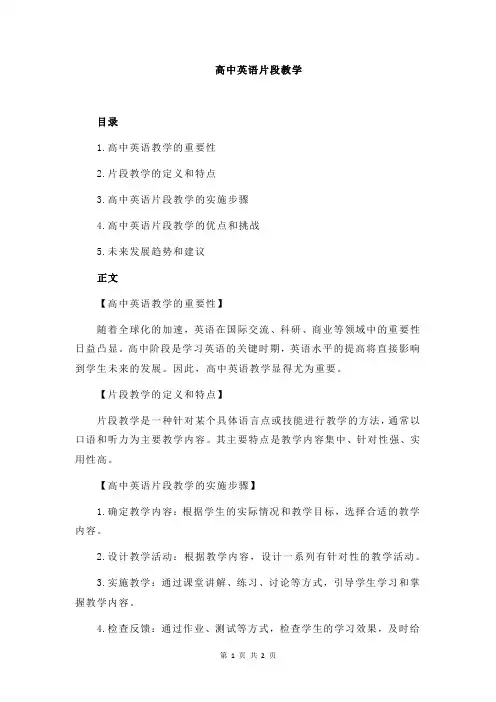
高中英语片段教学目录1.高中英语教学的重要性2.片段教学的定义和特点3.高中英语片段教学的实施步骤4.高中英语片段教学的优点和挑战5.未来发展趋势和建议正文【高中英语教学的重要性】随着全球化的加速,英语在国际交流、科研、商业等领域中的重要性日益凸显。
高中阶段是学习英语的关键时期,英语水平的提高将直接影响到学生未来的发展。
因此,高中英语教学显得尤为重要。
【片段教学的定义和特点】片段教学是一种针对某个具体语言点或技能进行教学的方法,通常以口语和听力为主要教学内容。
其主要特点是教学内容集中、针对性强、实用性高。
【高中英语片段教学的实施步骤】1.确定教学内容:根据学生的实际情况和教学目标,选择合适的教学内容。
2.设计教学活动:根据教学内容,设计一系列有针对性的教学活动。
3.实施教学:通过课堂讲解、练习、讨论等方式,引导学生学习和掌握教学内容。
4.检查反馈:通过作业、测试等方式,检查学生的学习效果,及时给予反馈。
【高中英语片段教学的优点和挑战】优点:1.提高学生的语言技能:片段教学针对性强,有利于学生更好地学习和掌握英语语言技能。
2.提高教学效率:片段教学集中于某个具体语言点,有利于提高教学效率。
挑战:1.需要教师具备较高的教学技能:片段教学对教师的教学能力和技巧要求较高。
2.教学内容的选择和设计需要费时费力:片段教学需要教师根据学生的实际情况和教学目标,精心设计和选择教学内容。
【未来发展趋势和建议】1.利用信息技术:随着信息技术的发展,教学手段日益丰富,教师可以利用网络资源、多媒体等方式,提高教学效果。
2.加强教师培训:提高教师的教学技能和专业素养,是提高片段教学质量的关键。
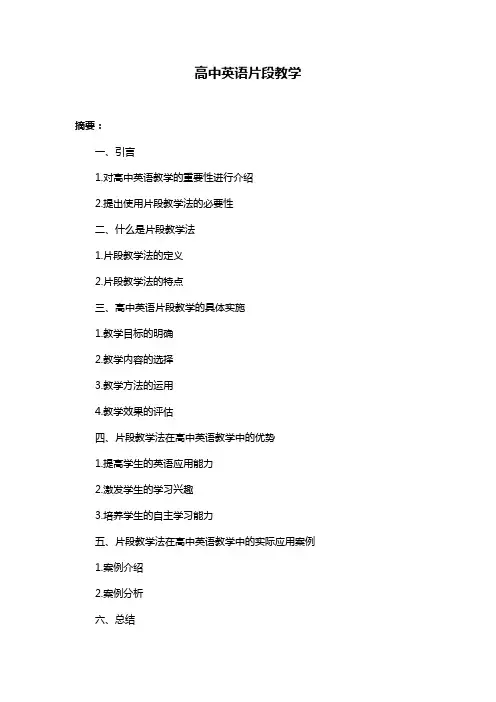
高中英语片段教学摘要:一、引言1.对高中英语教学的重要性进行介绍2.提出使用片段教学法的必要性二、什么是片段教学法1.片段教学法的定义2.片段教学法的特点三、高中英语片段教学的具体实施1.教学目标的明确2.教学内容的选择3.教学方法的运用4.教学效果的评估四、片段教学法在高中英语教学中的优势1.提高学生的英语应用能力2.激发学生的学习兴趣3.培养学生的自主学习能力五、片段教学法在高中英语教学中的实际应用案例1.案例介绍2.案例分析六、总结1.对高中英语片段教学进行总结2.对未来教学方法的展望正文:一、引言高中英语教学是整个英语教育体系中的重要组成部分,其教学质量直接影响到学生日后的英语学习甚至是整个人生的发展。
因此,如何提高高中英语教学质量成为了教育工作者们关注的焦点。
近年来,片段教学法作为一种新型的教学方法,被越来越多的教师应用于高中英语教学中,并取得了显著的成效。
本文将对高中英语片段教学进行详细的介绍和分析。
二、什么是片段教学法片段教学法,顾名思义,是指将一篇文章或一段文字拆分成若干个片段进行教学。
这种方法有别于传统的“从头到尾”的教学方式,而是将重点放在文章的局部,深入剖析,从而提高学生的英语应用能力。
片段教学法的特点主要体现在以下几个方面:1.目标明确:片段教学法强调对教学目标的明确,教师需要在教学前明确知道要教授给学生哪些知识和技能。
2.内容精选:片段教学法要求教师对教学内容进行精选,选取最具代表性和针对性的片段进行教学。
3.方法多样:片段教学法鼓励教师运用多种教学方法,如讲解、讨论、角色扮演等,以满足不同类型学生的学习需求。
4.效果评估:片段教学法强调对教学效果的评估,教师需要通过各种方式了解学生的学习情况,及时调整教学策略。
三、高中英语片段教学的具体实施1.教学目标的明确:在实施片段教学法时,教师首先要对教学目标进行明确。
例如,教师可以选择一篇英语文章,明确教学重点是让学生掌握某项语法知识或者提高阅读理解能力。
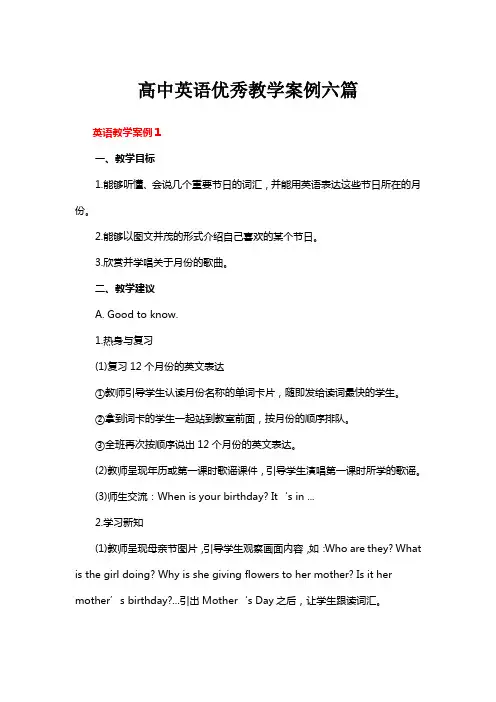
高中英语优秀教学案例六篇英语教学案例1一、教学目标1.能够听懂、会说几个重要节日的词汇,并能用英语表达这些节日所在的月份。
2.能够以图文并茂的形式介绍自己喜欢的某个节日。
3.欣赏并学唱关于月份的歌曲。
二、教学建议A. Good to know.1.热身与复习(1)复习12个月份的英文表达①教师引导学生认读月份名称的单词卡片,随即发给读词最快的学生。
②拿到词卡的学生一起站到教室前面,按月份的顺序排队。
③全班再次按顺序说出12个月份的英文表达。
(2)教师呈现年历或第一课时歌谣课件,引导学生演唱第一课时所学的歌谣。
(3)师生交流:When is your birthday? It‘s in ...2.学习新知(1)教师呈现母亲节图片,引导学生观察画面内容,如:Who are they? What is the girl doing? Why is she giving flowers to her mother? Is it her mother’s birthday?...引出Mother‘s Day之后,让学生跟读词汇。
英语教学案例2一、语言技能目标第一层次:1.能够听懂、会说衣服词汇cap,coat,shoes,sweater,jacket,gloves,trousers;能在四线三格中基本规范地抄写单词,并尝试借助拼读规律记忆单词。
2.能够听懂、会说用来介绍复数衣服的功能句:These are ...3.能够听懂、会说用来询问自己该穿什么衣服的功能句:What should I wear today?及其答语:You should wear ...,初步学会在恰当的情境中运用,并通过描摹句子来体会句子书写规范,为抄写句子和独立写句子打基础。
4.能够读懂介绍自己所在城市的季节、天气、穿衣情况以及询问对方城市相关情况的小书信;并通过替换小书信中的关键信息回信,介绍自己的上述情况,回复朋友的询问。
5.能够借助熟悉的旧单词和图片感知字母u在闭音节单词中的发音规律,并利用该规律拼出新单词的读音,进而尝试记住其写法。
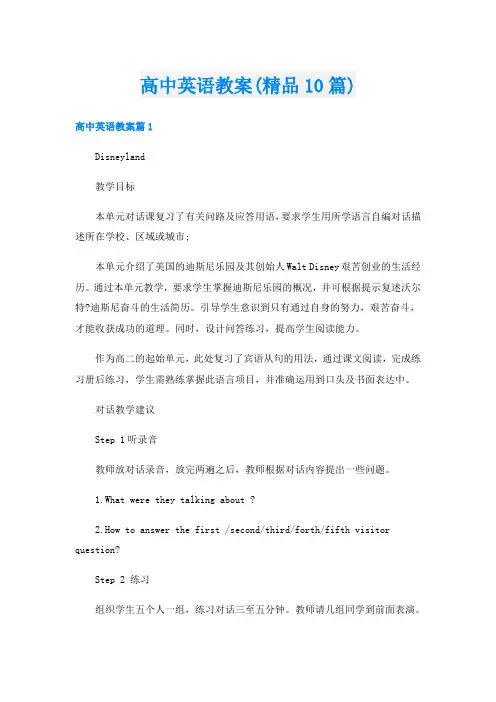
高中英语教案(精品10篇)高中英语教案篇1Disneyland教学目标本单元对话课复习了有关问路及应答用语,要求学生用所学语言自编对话描述所在学校、区域或城市;本单元介绍了美国的迪斯尼乐园及其创始人Walt Disney艰苦创业的生活经历。
通过本单元教学,要求学生掌握迪斯尼乐园的概况,并可根据提示复述沃尔特?迪斯尼奋斗的生活简历。
引导学生意识到只有通过自身的努力,艰苦奋斗,才能收获成功的道理。
同时,设计问答练习,提高学生阅读能力。
作为高二的起始单元,此处复习了宾语从句的用法,通过课文阅读,完成练习册后练习,学生需熟练掌握此语言项目,并准确运用到口头及书面表达中。
对话教学建议Step 1听录音教师放对话录音,放完两遍之后,教师根据对话内容提出一些问题。
1.What were they talking about ?2.How to answer the first /second/third/forth/fifth visitor question?Step 2 练习组织学生五个人一组,练习对话三至五分钟。
教师请几组同学到前面表演。
Step 3改写将对话内容改写为一篇短文,要求学生用本课的地点名称如:Sleeping Beauty Castle , Bear Country, Horse-drawn streetcars, the Tomorrow Land Building比如:Carl is answering visitors’ questions. The first visitor asks Carl the way to the Sleeping Beauty Castle….Step 4 讨论If you are visitor, How to ask the way to the stranger at first?Step 5总结教师提问学生们,归纳和总结对话用语。
Asking:Where is …...How can I get to…Which is the way to…Could you tell me if…Could you tell me the way to…Answering:Go straight ahead…It’s behind …/in frond of/Go down this street…教材分析本课的日常用语用语是有关对话asking the way and responses,这样的问路用语在初中都以学过,所以对话不在是个难点。
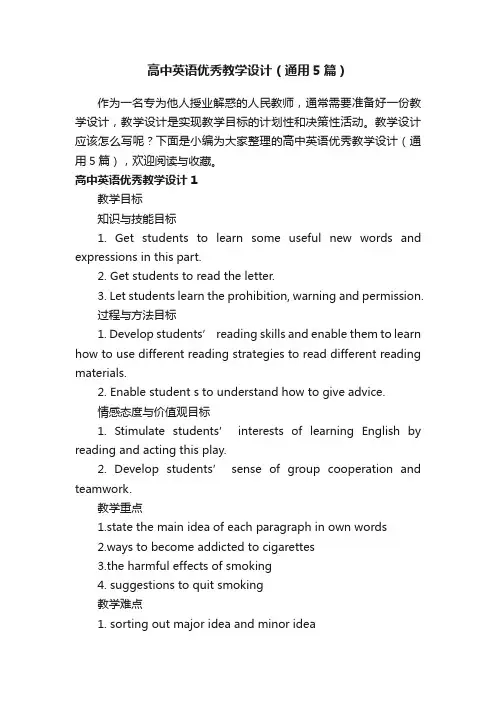
高中英语优秀教学设计(通用5篇)作为一名专为他人授业解惑的人民教师,通常需要准备好一份教学设计,教学设计是实现教学目标的计划性和决策性活动。
教学设计应该怎么写呢?下面是小编为大家整理的高中英语优秀教学设计(通用5篇),欢迎阅读与收藏。
高中英语优秀教学设计1教学目标知识与技能目标1. Get students to learn some useful new words and expressions in this part.2. Get students to read the letter.3. Let students learn the prohibition, warning and permission.过程与方法目标1. Develop students’ reading skills and enable them to learn how to use different reading strategies to read different reading materials.2. Enable student s to understand how to give advice.情感态度与价值观目标1. Stimulate students’ interests of learning English by reading and acting this play.2. Develop students’ sense of group cooperation and teamwork.教学重点1.state the main idea of each paragraph in own words2.ways to become addicted to cigarettes3.the harmful effects of smoking4. suggestions to quit smoking教学难点1. sorting out major idea and minor idea2. master key words in key sentence教学过程→Step 1 Warming upShow some proverbs on health1.An apple a day keeps the doctor away.2.Early to bed and early to rise, makes a man healthy, wealthy and wise.→Step 2 Skimming1How many parts does the reading text consist of?2. Who wrote the letter to whom?3. How many ways can a man become addicted to smoking?→Step 3 Scanning1. The first sentence of the letter shows James granddad______ .A. lives a healthy lifeB. is addicted to sitting in the gardenC. has nothing to do at homeD. is tired when cycling 20 kilometers2. From the second paragraph, we can know granddad ______________.A . never smoked B. likes smokingC. used to smoke heavilyD. still smokes now→Step 4 Detailed readingAsk students to discuss the following questions in pairs.(让学生分组讨论,形成书面形式)1.Different ways people can become addicted to cigarettes.2. Harmful effects for smokers吸烟的危害3.ways to quit smoking→Step 5 Post readingWrite some advice to persuade smokers to quit smoking→Step6 DiscussionHow to live a healthy life?→Step 7 Homework1. write down the suggestions given by granddad2. try to persuade one to give up smoking高中英语优秀教学设计2一、说教材本单元主要是围绕生日展开教学,要求学生掌握十二个月份和序数词的变化,以及日期和生日的表达。
编号:_____高中英语教案学校:_________教师:_____________年___月___日(此文内容仅供参考,可自行修改)第1 页共30 页高中英语教案unit3---a master of nonverbal humourthe second periodreadingteaching aims: 1.enable students to learn what humor means and what isnonverbal humor.2.to introduce the life and work of charlie chaplin.3.to introduce the kind of humour we can all laugh at---nonverbal humour4.to train the students’ reading and understanding abilitydifficult points: find out the main ideas of every paragraph.teaching aids: a recorder and a projector,multimediateaching procedure:step 1. greetings and revisioncheck homework: ask students to review what we learned in last period.step 2. pre-reading (通过展示几幅幽默图片,使课堂气氛活跃了起来,一下子调动了学生的积极性,然后顺势导入本课的主人公---charlie chaplin)questions: 1.what do you know about charlie chaplin?2.what do you know about his films?step 3 readingtask 1 :find out the main information about charlie chaplin第 2 页共 30 页1)born:___________________________________2)job:______________________________________________3)famous character:_________________________________4)costume:__________________________________________5)type of acting:_____________________________________6) died:_____________________________________________task 2: listen to the tape of the passage and match the main ideawith each part.para11. charlie’s childhoodpara22. his famous character (角色)para33. the charlie chaplin’s laughter (笑声)para44. his achievementspara55. an exle of his worktask 3: answer the following questions:1. what’s the passag e mainly about?a. the history of english humour?b. the films chaplin made.c. the humour chaplin made in his films.d. the gold rush in alaska.2. when and where is the film the gold rush set in?a. it is set in california at the end of the nineteenth century.b. it is set in canada at the end of the nineteenth century第 3 页共 30 页c. it is set in alaska in the middle of the nineteenth centuryd. it is set in canada in the middle of the nineteenth century3. charlie chaplin made people laugh when they felt depressed, sothey could feel____________a. less content with their livesb. more satisfied with their livesc. more worried about their livesd. they had a miserable lifetask 4: give a description on little tr.the little tr, a poor, homeless man with a moustache, wore asmall round black hat, large trousers and worn-out shoes carrying a walking stick.task 5: introduce the main films of charlie chaplin.the gold rush ,modern times,the great dictator...--> enjoy the part of the film ---the gold rush(利用多媒体播放卓别林的经典影片the gold rush中的片段,让学生体会以下大师的惟妙惟肖的表演,从而激发学生的好奇心,使其迫不及待地去读课文,更深入地了解“无声的幽默的大师—卓别林”.) task 6: after seeing the film, find the correct order of the followingevents.chaplin tried cutting and eating the bottom of the shoe.chaplin and his friend washed sand and expected to pick up gold,but they failed.第 4 页共 30 页they were so hungry that they boiled a pair of leather shoes.they were caught in a small wooden house.chaplin cut off the leather top of the shoe.chaplin picked out the laces of the shoe.step 4: post-readinganswer the questions: 1.besides joy, what else can humor bring to usin our studies and life?( relaxation, confidence, hope, joy, health, friendship, love...)2. the reasons for his success:( determination, devotion, optimistic attitude to life, kindnesssympathy to the poor... )3. give students a humorous story if time permitting.step 5: conclusiontoday we have learned something about humor, it is everywhere in our daily life. i hope you can be optimistic(乐观的) no matter what difficulties you meet with, just as charlie chaplin was.step 6: homework1.write a humorous story in english and find out the grammar itemsin this passage.2.pre-view the important s and expressions in the text.第二篇:重大版高中英语教案:《unit_3_powerful_music》unit 3第 5 页共 30 页powerful music(listening, speaking - writing)i. listening and speaking(25’)2.学习方法:step1:1)快速完成第1项任务,熟悉几种常见音乐类型的表达法,扩大词汇量。
⾼中英语教案模板(通⽤5篇)⾼中英语教案模板(通⽤5篇) 作为⼀名教师,时常需要⽤到教案,教案是保证教学取得成功、提⾼教学质量的基本条件。
我们应该怎么写教案呢?下⾯是⼩编帮⼤家整理的⾼中英语教案模板(通⽤5篇),欢迎⼤家分享。
⾼中英语教案1 ⼀、教学内容分析 本单元的中⼼话题是西⽅绘画艺术的历史和中西⽅各种艺术形式和风格。
听说读写都是围绕这个⽽展开的。
这节课的内容主要是围绕中国的绘画艺术的历史和风格及其各个时期的代表作品⽽展开的。
通过做听⼒训练和热⾝,让他们对艺术和绘画有⼀个⼤概的了解,从⽽为接下来西⽅艺术的学习垫定基础。
⼆、教学⽬标 1.aims of knowledge(知识⽬标) 1) to know the information about art 2) to know some relevant words and expressions 2.aims of abilities(能⼒⽬标) 1) to improve students listening ability by guessing the content and setting down the key words 2) to enable the students to understand the brief short history of the traditional chinese painting 3.affective aims(情感、态度与价值观⽬标) to arouse the patriotic spirit of the students and improve their team spirit by doing the group work 三、学习者特征分析 虽然这是选修七第⼀单元的第⼀个课时,学⽣在语⾔理解上会有⼀定障碍。
我们班学⽣男⽣为⼤多数,普遍听⼒较薄弱,也⽐较缺乏兴趣。
但是⾼⼆的学⽣通过⼀年多的⾼中英语学习,已经积累了⼀定的词汇,⽽且在听听⼒之前教师会让学⽣做热⾝,先熟悉⽬标词汇,使听⼒难度降低。
高中英语教案(优秀8篇)高中英语教学设计篇一单元整体设计思路第一课时:阅读课Warming up; Pre-reading; Reading; Comprehending (pp. 1-2)第二课时:语法课Discovering useful structures (p. 4); Using structures (p. 43)第三课时:阅读与听说课Reading and listening; Speaking (pp. 5-6)第四课时:词汇课Discovering useful words and expressions (p. 3); Using words and expressions (p. 42)第五课时:听说课Listening; Talking (p. 41)第六课时:读写课Reading and writing (p. 7)第七课时:单元评价课Self-test and self-evaluation; Summary第一课时阅读课一、教学内容Warming up; Pre-reading; Reading; Comprehending (pp. 1-2)二、教学目标在本节课结束时,学生能够了解文化遗产的基本概念、本质特点以及基本类型。
通过找读(scanning)关键词、略读(skimming) 和精读(careful reading),了解有关琥珀屋的故事。
用归类法学习词汇。
用自己的话复述琥珀屋的故事。
运用本课时学习的内容和自己已有的知识讨论相关话题。
三、教学步骤步骤一热身1.请学生看学生用书p. 1或者PPT中的图片,两人一组讨论三个问题。
教师请几组学生回答问题,然后综合大家的看法总结出文化遗产的定义。
2. 请学生说出一些中外文化遗产的名称,教师写在黑板上。
可以采取小组竞赛的形式,比一比看哪组说得多、说得正确。
注:问题中出现了五个生词。
rare, valuable和survive很难根据上下文猜出词义,教师可以布置学生课前查字典自学其词义,用法可以留到词汇课处理。
高中英语教案英文4篇高中英语教案英文篇1教学目标:学问目标:1. player and team, game2.win and lost能力目标:1. Demonstrate “win” and “lose” after the game is done2.play a game of “spelling Bee”情感目标:When you get lose, you don’t lose your heart. Try it again and again. You will win at last.教学重点、难点:1. words about the game2.win and lose教具、学具:A big picture of this lesson and a tape教学过程:Class opening and reviewPlay “Charades”to review occupations the students mastered in Levels 1, 2 and 7: teacher, clerk, cashier, waitress and bus driver. After the students have guessed these occupations, add “doctor” and “police officer”. The students mastered these words orally in Level 1, but they haven’t seenthem for a long time. Whisper the translation for these occupations to the students acting them out, and help the class guess the occupations with lots of prompts and encouragement. You can, for example, draw blanks on the blackboard and slowly write in the letters as you soundout more and more of each occupation.IntroduceDemonstrate “player”“team”“game” with six volunteers and a game of “spelling bee” divide the volunteers into two teams of three. Give player a sheet of coloured paper to hold, the same colour for each team.Demonstrate “win” and “lose” after the game is done. Point to the teams and as you say “You win/lose”Use the student bookPause after Number 1 in the student book.Review the story so far. Li Ming and Jenny have been learning about sports. Look at the pictures in the student book. What are they doing now?Note some of the idiom in this lesson: Bob plays basketball “for fun” Jenny and Li Ming “jump up and down” Li Ming asks Jenny “What’s the score?” What do the students think these phrases mean?PracticeDivide the class into small groups. In each group. Some students pretend that they want to learn a game that the other students know how to learn a game that you play in class.Do the activity bookClass closing高中英语教案英文篇2教学目标学问与技能(1)熟练把握下列词汇:rules, arrive, late, hall, dinning hall, listen, , fight, sorry outside,wear, important, bring, uniform, quiet(2)熟练把握下列短语:dining hall, arrive late for school, (be) on time, listen to music break the rules, in class, be/ keep quiet, a lot of, bring …to…,wear a hat, have to, music players(3)把握下列句型:1. Dont eat in class.2. You must be on time.3. Eat in the dining hall.4. 正确使用情态动词can, can’t——Can we wear a hat in school?——Yes, we can./No, we can’t.5. 能正确使用have to 和 must 谈论规章制度We must be on time/ We also have to be quiet in the library.教学重难点重点:1) 确定祈使句是省略掉主语的原形动词开头;2) 否定祈使句则是在确定祈使句前加上“don’t”。
高中英语优秀教学教案(通用5篇)篇一:高中英语优秀教学教案通用一、教材分析^p :学生在度过一个假期后,英语知识较陌生,老师应当复习好以前单词,为学习新知打下根底。
Let’s talk A局部很好地表达了这一点。
Good morning We have a……复习民第一册中内容。
“I’m from America”这一句为B Let’staik“Where are you from?做了铺垫,老师应充分注意这一点。
boy、girl 、teacher student 、meet等单词又是第一次出现,也需要我们特别关注。
二、教学目的:1、可以得简单地表达自己心情,如:nice to meet you wele back to school2、可以听懂并答复 Where are you from?I’m from3、认识、会说字母A——E4、掌握A、B Ler’s talk中单词。
5、理解A、B Ler’s talk中内容。
三、教学重、难点:可以听懂并答复 Where are you from?掌握A、B Ler’s talk中单词。
理解A、B Ler’s tal k中内容。
四、课时安排第一课时 A lLet’s talk Let’s learn B Let’s sing第二课时 A Let’s practise Let’s play Let’schant第三课时 B lLet’s talk Let’s learn第四课时BLet’ssay Let’spractise第五课时 B Let’s Let’s第六课时 C story time篇二:高中英语优秀教学教案通用教学目的1、引导学生通过上下文理解生词的含义:anecdote, annual, witness, acmodation, shore, yell, pack, flee, drag, depth, lip, tongue, abandon, relationship, help out2、帮助学生掌握文中一些描绘事物和情景的生动手法,从而体会作者的思想情感,把握文章的精华。
英语教案高中教学范文5篇英语(English)是印欧语系-日耳曼语族下的语言,由26个字母组成,英文字母渊源于拉丁字母,拉丁字母渊源于希腊字母,而希腊字母则是由腓尼基字母演变而来的。
接下来是小编为大家整理的英语教案高中教学范文,希望大家喜欢!英语教案高中教学范文一《Unit 1 Friendship》大家好!今天我说课的内容是高一英语新课程实验教科书必修1 Unit One, The first period。
下面我就从教材分析、教法分析、学法分析、教学过程、教学评价五个方面进行说明。
一、教材分析(一)教材的地位和作用本节课是本单元以及本教材的第一节课,本课谈论的是:朋友是不是仅限于人类、朋友的真正含义、如何与人相处的问题等关于朋友的话题。
本课涉及的有陈述句和疑问句的直接引语和间接引语的掌握和运用等语法要点。
学生从初中到高中,来到一个新的学校,同学彼此陌生,不免想起老同学,老朋友。
这样的话题正好能引起学生的兴趣。
而且本课的内容和语法的启发性和实用性都很强,能使学生在学中用,在用中学,对综合提高学生的听说读写能力有较好的促进作用。
(二)教学目标英语教学大纲规定,通过听说读写的训练,使学生获得英语基础知识和运用英语的能力,激发学生的学习兴趣,为进一步学习打下良好的基础。
因此,我制定以下教学目标:知识目标:1、掌握和使用陈述句和疑问句的直接引语和间接引语。
2、讨论朋友和友谊。
3、学习掌握本课的重点词汇。
技能目标:1、学会阅读的技能——scanningand skimming 。
2、通过谈论朋友和友谊,既锻炼学生的语言运用能力,又培养了学生发现问题、思考问题、解决问题的能力。
3、理解阅读文段,复述故事。
情感态度:1、患难之交才是真朋友。
2、知音难得。
3、海内存知己,天涯若比邻。
文化意识:认识德国纳粹党。
让学生了解那段德国法西斯残害犹太人的历史,使学生在感受外国历史文化的同时自然而然的习得语言。
(三)重点与难点重点:1、训练scanningand skimming等阅读技能。
高中英语片段教学教案
【篇一:高中英语参赛教学设计】
unit3 a taste of english humour
reading: a master of nonverbal humour
教学设计
云县一中肖会全
1
2
3
4
5
【篇二:视听课中的高中英语词汇教学设计】
龙源期刊网 .cn
视听课中的高中英语词汇教学设计
作者:李国丰
【摘要】我们既要遵循视听课的教学原则,重视语言习得规律,又要结合学生特点和兴趣来设计课堂活动,充分调动学生学习的积极性和主动性,从而全面提高学生语言综合运用能力。
本文依据词汇的习得规律,结合教学设计,介绍视听课中的高中英语词汇教学方法。
【关键词】视听;词汇教学;设计
一、视听课中的高中英语词汇教学背景
视听课在英语词汇习得过程中占据着至关重要的地位,视听课的开展极大地提高了英语学习者的学习兴趣,这种并非传统的课型在帮助学习者提高听说能力方面具有很多优势。
“视”与“听”的综合是视听课优于传统的为听而听的单一而纯粹听力课之处,毕竟在传统的听力课上,学习者只能锻炼听力,是一个纯粹的输入过程。
如果在视听课中能有效渗透词汇教学,巧妙设计词汇教学环节,不仅可以加深学生对文学成就、历史背景的了解,而且有助于提高学生文学欣赏水平、语言的综合运用能力,将视听教学作为输入过程,词汇教学作为输出过程,最终实现教学过程中输入输出的有机结合。
二、视听课的教与学现状
(一)教师方面:教学理念陈旧,教学设计乏味
大部分教师在平时的教学过程中只是提供标准试卷形式的听力材料,播放录音,然后对答案。
不清楚学生除了听大意、听细节训练之外,还有一些其他能力要求,如猜测词义、判断语气、推测说话者意图、预测后面结果等微技能训练。
教材中的听力教学设计环节被大大删减,舍弃的同时并没有积极开发和合理利用其他听力课程资源,忽
视精听泛听。
以测代练,训练方式单一,违背了听力教学循序渐进
的原则,为了“听”而“听”,学生疲于面对答案的压力。
(二)学生方面:缺少在视觉和听觉的体验中词汇习得的机会
在视听过程中,捕捉信息词是理解说话人意图的关键。
如果学生在
视听中对词汇的辨音、否定词、非谓语动词、比较级结构和复合句
式等辨认不到位,就会失去对关键信息的把握,无法辨认说话者的
意图。
视听理解和学生词汇量的直接关系显而易见,很多同学不注
重词汇量的积累,再加之视听材料中有许多专有名词、习惯用语、
俚语、美式英语和英式英语的发音区别等难以理解,从而造成学生
听力困难,一旦在听力理解中遇到生疏的新词或短语,就会分散注
意力,无法完成理解,停滞或放弃。
三、视听课中的高中英语词汇教学行动对策——教学设计
【篇三:高中英语必修一unit 1 friendship教学设计】
高中英语必修一unit 1 friendship教学设计
第一课时
warming up
第一步:教师可以采用以下的不同方式引出本单元的话题;
方案一:
可以直接利用课本热身部分提供的问题来引出话题。
这一方案开门
见山,不仅能很快切入本单元的主题,而且问题指向明确,学生比较容易
展开话题。
方案二:
可以利用其它更为生动、灵活的方式如:在黑板上写下几种“朋友”
这个词在不同语言里的表达,让学生猜这些词的意思以激发学生的
学习兴趣(教师最好能知道这些不同表达的书写和读音,还可以让
学生在课堂上试写和试读);也可以播放一首以友情为主题的歌曲(无印良品:《朋友》;老狼:《睡在我上铺的兄弟》)或一段描
述友谊的电影片段(韩国电影《朋友》导演:郭京泽主演:张东健),然后让学生就所播放素材的主题展开讨论,进入本单元话题;
教师还可以引用一些国、内外谈论朋友的名人名言(见背景资料)
来展开话题。
方案三:
可以事先让学生准备一张好朋友的照片,然后在课堂上让学生展示
自己的朋友的照片并描述其主要特点。
也可以让学生介绍自己新学
期在新的班级里交到的朋友(此方案适合程度较好的班级)。
开展活动时可以全班一起进行,也可以分小组进行,但要提醒学生
用英语进行表达。
教师可以事先做一个brain-storm,在黑板上列出
一些描述人物的常用词汇和句型以帮助学生顺利完成接下来的活动,如:
personality:kind generous humorous
appearance:handsome pretty good-looking tall
hobby:sports reading traveling
in my opinion / i think / as to me, he (she) is a ... person.
he(she) always wears ....
he(she) looks like....
we always do ... together.
第三步:小组活动,学生分成若干小组,讨论朋友之间建立友谊的
基础,可能会出现的问题以及相应的解决方法或建议;
第四步:学生发表讨论结果;
方案一:
直接提问学生,公布讨论结果。
方案二(此方案适用于程度较好的班级):
教师设计一个小型的采访活动让学生分角色进行role-play(教师根
据学生的实际语言基础来要求讨论和发言时使用的语言,应鼓励学
生尽量用英语表达并且提供相关的句型和词汇作为提示,如:
what kind of person are you according to the survey?
do you thin can be a good friend to others? and how?
what do you think are the basients we need to r friendship?
第五步:教师整理学生讨论和发言的内容,并针对友谊这一话题提
出自己的看法和建议供学生参考, 如:everyone needs friend.(如
果条件允许还可以要求学生在课后将在讨论中得出的好方法和建议
搜集起来制作成小册子互相传阅和学习)。
pre-reading
第一步:小组讨论:does a friend always have to be a person? what else can be your friend? 第二步:教师根据学生的答案引出
阅读部分的话题,可以增加更为具体和深入的问题,如:
how can animals / other things be our friends?
what are the (dis)advantages of having ... to be our friends? using language
listening (page 6)。